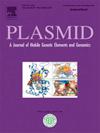Rep_3 plasmids found in Acinetobacter species that include orfX also harbour dif modules
IF 2.2
4区 生物学
Q3 GENETICS & HEREDITY
引用次数: 0
Abstract
Plasmids found in Acinetobacter species are not found in other Gram-negative species. There are many distinct plasmid types and the majority encode a Rep_3 family RepA replication initiation protein. Among these, a number were known to carry dif modules. Here, the representative plasmid for each of the 78 reported R3 types was examined to identity features of the plasmid backbone that are associated with the carriage of dif modules. A conserved open reading frame designated orfX (IPR047783) was found downstream of repA in 35 of them, and the backbones of those 35 plasmids were bounded by recombination sites recognised by XerC and XerD, known as pdif sites. These plasmid backbones are all equivalent to a C-type dif module as the pdif sites are in the orientation D/C at one end and C/D at the other end, i.e. the XerC binding sites are internal. Hence, to provide the XerD binding sites and generate a complete plasmid at least one D-type dif module is needed. Phylogenies of the RepA and OrfX proteins revealed that plasmids with closely-related RepA proteins are not always associated with closely-related OrfX proteins and vice-versa indicating extensive backbone recombination. Folded structures of diverse OrfX proteins predicted using AlphaFold 3 revealed an N-terminal HTH domain followed by a long α-helix that is predicted to promote dimerization and a disordered C-terminus. Given the correlation between the presence of orfX and one or more dif modules, the possibility that OrfX is involved in dif module movement deserves to be investigated.
在含有orfX的不动杆菌中发现的Rep_3质粒也含有dif模块
在不动杆菌中发现的质粒在其他革兰氏阴性菌中没有发现。有许多不同的质粒类型,大多数编码Rep_3家族RepA复制起始蛋白。其中,一些已知携带dif模块。在这里,研究了78种报道的R3类型的代表性质粒,以确定与dif模块携带相关的质粒主干的特征。在其中35个质粒的repA下游发现了一个保守的开放阅读框orfX (IPR047783),这35个质粒的主干被XerC和XerD识别的重组位点(称为pdif位点)所包围。这些质粒骨架都相当于C型dif模块,因为pdif位点一端在D/C方向上,另一端在C/D方向上,即XerC结合位点在内部。因此,为了提供XerD结合位点并生成完整的质粒,至少需要一个d型dif模块。RepA和OrfX蛋白的系统发育表明,具有密切相关RepA蛋白的质粒并不总是与密切相关的OrfX蛋白相关,反之亦然,表明广泛的骨干重组。利用AlphaFold 3预测的多种OrfX蛋白的折叠结构揭示了一个n端HTH结构域,随后是一个长长的α-螺旋结构域,预测其促进二聚化和一个无序的c端。鉴于orfX的存在与一个或多个dif模块之间的相关性,orfX参与dif模块移动的可能性值得研究。
本文章由计算机程序翻译,如有差异,请以英文原文为准。
求助全文
约1分钟内获得全文
求助全文
来源期刊

Plasmid
生物-遗传学
CiteScore
4.70
自引率
3.80%
发文量
21
审稿时长
53 days
期刊介绍:
Plasmid publishes original research on genetic elements in all kingdoms of life with emphasis on maintenance, transmission and evolution of extrachromosomal elements. Objects of interest include plasmids, bacteriophages, mobile genetic elements, organelle DNA, and genomic and pathogenicity islands.
 求助内容:
求助内容: 应助结果提醒方式:
应助结果提醒方式:


